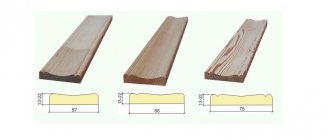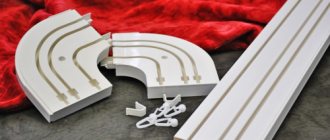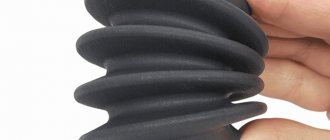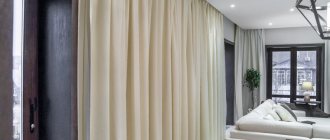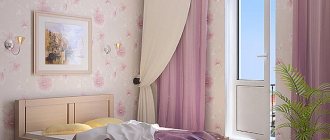Fastening the transfers to the pipe
In order for the crossovers to stay on the tubular cornice and not move or move in different directions, they must be securely fixed in a strictly defined place.
Usually Velcro is used for this purpose. There are different methods of fixation, let's consider one of them. The soft part of the Velcro tape (“mother”) is sewn to the crossover, and the hard part (“male”) can be glued to the pipe in the right places.
But I was faced with the task of attaching Velcro to the cornice so that it would hold well and be mobile, since in addition to the lambrequin, tulle would also hang on the same pipe.
After some thought, I decided to use an elastic band. I’ll make a reservation right away that this method can only be accepted if the pipe can be removed from the fastenings.
The shoulders of the crossovers are narrow; to secure them, I cut Velcro 6cm long. It would be good to use an elastic band 5-6cm wide, but I only had a 2.5cm elastic band available. Therefore, for each fastening I cut two rubber bands 5cm long. The pipe is 1.5 cm in diameter, its girth is 6 cm, therefore we reduce it by 1 cm so that the elastic fits tightly around the pipe. If the diameter of the cornice is 2.5 cm, then it will be possible to reduce it more, at least 2 cm.
I simply glued the elastic bands to the Velcro with a glue gun.
This is what happened.
I sewed the transitions together.
I sewed the Velcro so that the stitching seam ran in the center of the tape, and I folded all the protruding corners of the seam allowances under the tape.
The excess fabric was “cut off” with a soldering iron.
This is how it will be attached to the pipe.
The lambrequins are made of lightweight fabric, so they hold up well. If the fabric is very heavy, then it is quite possible that under the weight of a heavier part (long overhang on the side), the lambrequin in this place will move towards the overhang; this must be taken into account when choosing a fastening method.
Well, ready-made lambrequins.
If something is not clear, ask in the comments, I will answer all your questions.
Did you like the master class? I would be very grateful if you share this article with your friends on social networks by clicking on any button below.
If you would like to share your experience with the readers of the site or simply show your work, write and send a photo to me by email.
Several main types of fastening lambrequins
To begin, you need to acquire the following elements in advance:
- cornice;
- double-sided adhesive tape;
- braid.
Before installation, you should decide on the width of the cornice; it can be slightly wider than the window opening or be located along the entire length of the wall. There are no strict regulations regarding this issue; here users are guided solely by personal preferences.
There are usually no problems with installing the cornice; you need to make markings and drill several holes with a hammer drill, into which dowels are then driven. Next comes the rigid base, and it is for this that you will need double-sided adhesive tape. To fix the tape more securely, you should use construction adhesive.
If the choice is made on a soft model, then very often braid (curtain or curtain tape) is used to secure such a fabric. Then you will need to sew a curtain tape to the product, and plastic hooks are inserted onto the front side of the fabric. The hooks must be evenly distributed along the entire length of the product, the distance should not be more than 10-15 cm, otherwise instead of neat folds you will get an ugly sagging of the fabric.
Rigid lambrequin - design features and application options
The scope of application of this design element is not limited only to its functional purpose.
In addition to draping the upper section of the window opening, a rigid lambrequin is used to form a single color space for the room, as it is suitable for all types of windows and goes well with most styles and interior design solutions. Basic moments
A rigid lambrequin, or bandeau (from the French - “bandage”, “ribbon”) is an element of drapery with a solid wooden or fabric base. In some cases, filler is added to add volume - holofiber, padding polyester, cotton wool. The shape of such a lambrequin can be very diverse and is determined by the style features of the design.
- The bends of the lambrequin allow arbitrary sizes. The front part is often given an arched or window shape.
- The bottom edge can be either straight or curly. There are solutions with repeating fragments.
- When finishing, a wide variety of accessories are used - brushes, glass beads, fringe.
- Using certain combinations of shape and contrast, you can achieve a layered effect.
- For draping small windows, designs with elongated sidewalls are often used.
- All kinds of cords and braid can add additional elegance to the lambrequin.
When choosing materials for making rigid jewelry, you should focus on fabrics with a large pattern. In this case, the lambrequin will be clearly distinguishable among the folds and gathers. If you have colors with vertical patterns, you can get an interesting effect by turning the canvas ninety degrees. In some cases, drapery design involves the production of decorative elements according to individual sketches (the same or contrasting material is used).
How to attach a rigid lambrequin
As a rule, fastening a rigid lambrequin is carried out on a cornice with a flat surface. Forged or tubular cornices are rarely used, as they require special drapery. However, in some cases, the lambrequin is attached directly to the curtain or hung on a pipe, if the design of the cornice allows this. Typically, rigid window decorations are attached so that the top edge protrudes 10 cm above the edge of the curtains or drapes Bedroom curtains or window dressings
.
The best solution for installing a rigid type lambrequin is ceiling cornices. On the one hand, they have a flat surface, and on the other, a more reliable frame. In this case, the product hides the cornice structure, visually increasing the height of the room. As for the fastening itself, it is worth mentioning the two most popular methods: using braid and Velcro tape, which is attached with the soft part to the fabric and the hard part to the surface of the cornice. As a rule, Velcro should be preferred. Its use ensures the absence of sagging, the likelihood of which exists when using braid.
If it is necessary to have a ceiling cornice in the overall composition of the window opening, the hard part of the Velcro tape is attached to its inside, and the soft part is attached to the lambrequin from the front side. In addition, one of the advantages of such curtain rods is the ability to install them on suspended or suspended ceilings.
Use Cases
Hard type lambrequins also include a narrow decorative strip no more than 8 cm wide, which can act as a full replacement for the ceiling cornice baguette. The use of such a narrow lambrequin makes sense if there is a discrepancy between its appearance and the overall design style. It is made from the same material as the main composition. In this case, it is additionally allowed to use a soft type lambrequin (suspended on a cornice or attached directly to the body of the strip). In some cases, the use of rigid decor may be justified when creating an interior designed in a strict business style. For example, meeting rooms or an office, the furnishings of which do not allow excesses in the form of folds or additional decoration.
General recommendations for securing drapery
Product made from durable materials
Apartment decoration: curtain design + tulle + cornice + lambrequin - all these concepts are interconnected, because they relate to the design of the room. As mentioned above, window decoration plays a major role in this process, so it is extremely important to correctly select all the necessary elements and details.
So, for example, if there are curtains, then the presence of a rigid lambrequin is implied. In addition to this, there are also soft and combined ones.
The decorative lambrequin for the cornice is mainly made from the same fabrics that are used when sewing porter or companion fabrics. Products made from lightweight materials - organza or transparent veil - look most attractive. Tiebacks, decorative cords, pompoms, tassels - all these accessories complete the composition.
Labrequin - a true decoration of curtains
Cornice installation process
How to attach a lambrequin to a cornice - this is a question that arises for all those who decorate a window on their own. First of all, we would like to note that the product is fastened to special cornice guides.
Note! Attaching drapery to the cornice is not an easy task. Buying a lambrequin or ordering one according to your own design is nothing compared to installing it. Therefore, if you are not confident that you can handle this process yourself, it is better to seek help from professionals.
So how to attach a lambrequin to a cornice?
To do this you will need:
- lambrequin;
- ceiling or wall cornice;
- duct tape;
- curtain tape.
First you need to get a cornice of the right size. It can be purchased at the store. There are a lot of varieties. The price depends on the material of the product - wood, metal, plastic.
Photo diagram of the installation of a round cornice
The installation instructions are as follows:
- Carry out the markings . The fastening points should be opposite each other, and the distance from the window opening on both sides should also be the same.
- Drill holes and insert dowels.
- Fix the cornice firmly with screws.
Attach the drapery to adhesive tape
Attaching Velcro to the baguette
The best option is to get a curtain rod with Velcro. However, not all owners have this opportunity. The table below describes how to attach drapery to different types of curtain rods.
| Type of cornice | Attaching the drapery |
| Ceiling | The adhesive portion of the tape must be attached to the outside of the installed ceiling cornice. For reliability, you can use glue. |
The soft part of the tape is attached to the underside of the drapery - usually there is a special hidden seam for this.
If it is not there, then you can use transparent fishing line. The drapery is attached to the cornice by connecting two ribbons.
By connecting two parts of the ribbon, you get an elegant and neat drapery.
What to look for when choosing?
The main criterion when choosing an option for attaching textile fabric is the type of cornice itself. Modern devices with hooks in the runners allow only one type of hanging of curtains: on curtain tape. But old-style curtains, with 1-2 rods on brackets, allow you to use curtains with rings, eyelets, and many other interesting solutions.
In addition to the type of cornice, attention is also paid to the structure of the material from which it is planned to sew the curtains. For thick curtains, it is better to choose the classic version with rings. This method will help create smooth folds and make closing curtains easier to move.
Particular attention is paid to the style of home decoration:
- For interiors in non-classical but strict styles (for example, minimalism), thick curtains can be made with eyelets. Correctly installed rings will help you easily form uniform, uniform folds. Most often, thin tulle items are hung on eyelets.
- For styles that allow the use of lambrequins (classic, Victorian, etc.), it is better to choose a ceiling cornice with hooks and hang 2-3 layers of textiles on the curtain tape. You can attach the lambrequin to the ceiling cornice using Velcro tape (Velcro), gluing 1 part of it to the front panel of the cornice.
- In Provence, country style rooms and other simple interiors, fastening options such as a drawstring or ties on the upper border of the canvas are appropriate. There are many design options for such products: from naive bows to stylish and laconic flaps with buttons or buttons.
Tips for choosing a form
Using window design, you can visually increase or decrease the space.
Much depends on the height of the ceiling. If the height of the walls is small, you should choose a narrow lambrequin; it will help visually make the ceiling higher.
Window decoration in the living room Source youtube.com
In most residential premises, the ceiling height is standard; in this case, you can choose a lambrequin with a height of 30-40 cm.
In a country house or spacious apartment, you can use a 40 cm high lambrequin, this will help make the window more proportional. In some cases, the increased height looks very harmonious and stylish in the interior.
Lambrequin for the living room Source allstroygroup.ru Window decoration in a cozy living room Source allstroygroup.ru Window decoration in a spacious living room Source dizainvfoto.ru
For a spacious hall, you can choose a more massive, voluminous design. Combined options for curtains with lambrequins are suitable.
The large area of the room allows you to use a wide variety of options for decorating windows.
To add width to the window opening, you need to place a lambrequin outside it.
Design option for a spacious living room Source roomester.ru
Installation Features
Cornices are attached to the ceiling or wall. Ceiling options are used when:
- there is no possibility to fix the brackets on the wall (cladding made of gypsum plasterboard, small distance from the opening to the ceiling, etc.)
- window sills protrude greatly above the wall surface;
- installation of a lambrequin is planned;
- part of the room is separated (studio area).
In other cases, different types of wall mounts for curtains are used:
- rod (tubular);
- string;
- profile (for complex openings of windows or doors, double curtains);
- rail (resembles ceiling ones, but is mounted on a bracket to the wall).
Ceiling and wall varieties have their own installation features:
- Ceilings are fixed to the ceiling using dowels with self-tapping screws, without the use of additional parts. The fasteners are screwed in through the standard holes. Not only baguette varieties can be fixed to the ceiling, but also string, as well as flexible profile systems. The latter allow you to create a curly line when separating a zone in a room.
- To mount wall-mounted varieties, use suspension supports included in the product package. Depending on the type of product, a rod, string, or profiles made of metal or plastic are used as a cornice. In this case, the fasteners are screwed into the wall through the holes of the bracket, and the cornice itself is attached to the support.
Results
Elegant window decoration
As you can see, the process of attaching a lambrequin is not that complicated. The result will undoubtedly please you, because thanks to the lambrequin an atmosphere of warmth and comfort is created in the room.
A beautifully designed window space looks original and attractive compared to standard curtains and tulle. The main thing is to successfully choose the fabric, color and design of the product, because it is thanks to this that you will achieve maximum harmony.
For example, high fastening of the structure will visually lengthen the height of ceilings and walls, while a wide product will expand the boundaries.
We wish you success and successful experiments. The video in this article will clearly depict the entire process of attaching a lambrequin.
Window decoration is a special art. In order to create a cozy homely atmosphere, it is necessary to combine many elements that will not only complement each other and harmoniously combine with the existing interior, but also perform a special function.
Thick curtains protect the room from prying eyes, airy curtains help daylight penetrate inside, and a lambrequin most often helps to hide some imperfections and, of course, performs a special decorative function. Today we’ll talk about how to hang a lambrequin correctly.
Interesting options
Both traditional and modern types of curtain fastenings are versatile enough to harmonize with different room design styles. It is important to choose the appearance of these fasteners (rings, eyelets, ties, etc.) in accordance with the decoration of the room. Curtains are a large and always attention-grabbing element of the interior, therefore each of their details should be combined with the design and purpose of the room.
Ties
Ties for fastening curtains are used in the design of a living room, bedroom or nursery. They will also be good in the kitchen. This type of hanger is made from wide or narrow ribbons, and from the same material from which the curtain is made. Depending on the style of the room, the ends of the strips of fabric sewn on top are tied with a simple knot (suitable for a rustic style, appropriate in a kitchen or nursery), or a lush bow (Provence, shabby chic). In a classic interior, ribbons can be tied with a complex, beautiful knot.
The only drawback of ties is the need to make many identical knots right in the process of hanging the panel. If the cornice is high, this can be physically difficult: the length of all loops after tying must be the same, otherwise the curtain will warp.
Loops
A variant of the previous method of decorating the top of the curtain involves the use of already closed loops from the same ribbons or strips of fabric. Unlike ties, loops are sewn to the fabric with their free ends. You can arrange them in different ways:
- just fold the strip in half and sew;
- decorate the outside in the form of a flap with an eye-catching clasp;
- add a ring of fabric to the straight loop, tightening its base;
- make loops in the form of a zigzag from 1 long ribbon, etc.
How to expand the space and raise the ceiling
Designers claim that experiments with installing lambrequins can only be done if the ceiling in the room is not below 2.7 m, and if the room is spacious enough, otherwise curtains with such decorative elements will visually make it more bulky.
The lambrequin should be hung so that its upper part coincides exactly in the middle with the line of the window opening. At the same time, it is advisable to raise the edges of the canvas a little. These secrets will help you achieve the effect of a window smile. You need to carefully fasten it, because low edges will visually lower the ceiling. Often designers recommend using active vertical lines in the design. To do this, you need to make folds 0.5-1 m wide, falling evenly to the floor. The volume of drapery is selected depending on the size of the window opening. It is advisable to purchase curtains that will have a brighter color palette than the lambrequin. You can also use a fabric with contrasting color. This will also visually lift the space.
The lambrequin can be easily stylized. It is not necessary to use the classic version, and then it can fit even into an ultra-modern interior. In a high-tech style, the role of a decorative structure will be well fulfilled by a raised blind - this is what is commonly called in the design world for an ordinary Roman or roller blind. A few fancy valances will help you achieve layering without being too pompous. Design techniques for a stylized design are no different from those used for the classic version. If the canvas is mounted high, the height of the walls and windows will visually increase. If you make the roller blind wide, protruding far beyond the side walls of the window, the boundaries of the opening will expand.
How to decorate custom windows?
For windows of complex shape, inclined attic, panoramic openings, you can choose suitable curtain options:
- roller blinds that can be glued directly above the glass, covering only it;
- Pleated blinds are also suitable for triangular openings; they can be fixed in the middle of the window or at the bottom of it;
- hourglass curtains do not open, and are made of transparent fabrics, securing both the bottom and top of the product directly next to the glass;
- for an arched window, a profile cornice with any type of curtains is suitable;
- in a bay window, the same profile can be conveniently installed around the perimeter of the room on the wall or ceiling.
Framing a non-standard window can also be done using simple curtains, attaching curtains to ceiling cornices, or using a rod, installing it below the upper, shaped border of the opening.
How is the fastening process carried out?
The first thing you need to do is purchase a cornice from the store that has the appropriate size. As for the length, it all depends on the preferences of the owner. Now you need to make markings on the ceiling, and drill holes there. Dowels must be inserted very carefully into these holes. The cornice is rigidly fixed, screws are tightened on it.
Scheme for attaching the lambrequin to the cornice using Velcro.
How to attach a lambrequin to a cornice using adhesive tape? Its sticky part must be glued to the outside of the ceiling cornice, so that everything is fastened securely, you need to use glue.
Now the soft part of the tape should be attached to the underside of the hard lambrequin, for this you need to use a hidden seam, all this is done so that the external attractiveness is not spoiled. For this, you can use threads, but a simple fishing line is also suitable, which, due to its transparency, is not visible, thereby not disturbing the overall aesthetics. The lambrequin is attached to the cornice as tightly as possible; to do this, you need to connect the two sides of the tape.
If the ceiling curtain rods are decorated with a spectacular baguette (which happens very often), then such beauty, of course, should not deteriorate. The soft part of the tape should be carefully sewn to the front side of the lambrequin. As for its sticky side, it should be glued to the back of the baguette. It is necessary to connect two parts of the baguette, resulting in an exceptionally elegant drapery.
In the event that a tubular or forged cornice is used, but you still want to attach the lambrequin to the cornice, you will need to use a special fastener (in most cases it is sold separately). Before you begin such installation, you need to look at the catalogs in advance to have an idea of how everything will look in the house. If you install a cornice for a lambrequin in a bay window or to the ceiling, you must use a flexible profile. It will be located behind a wrought-iron cornice. It is fixed on a profile, which is purchased additionally, and all this is secured with adhesive tape or braid.
Ceiling cornice assembly diagram.
To do everything neatly, you need to attach hooks made of plastic to the front side of the cornices. Then you need to sew a ribbon to them to hang the curtains. After which everything is hung on hooks and leveled. It is recommended to place the hooks as close to each other as possible, then there will be no need to worry about sagging.
If the lambrequin is fixed directly on top of the cornice, then it seems that the curtains originate from the ceiling. If such a device is heavy, then there is a possibility of sagging in cases where braid is used. In this regard, you need to use Velcro, thanks to which the lambrequin hangs evenly and does not sag.
Thus, such a process is not complicated. And the result that will be obtained at the end will undoubtedly please you. It should be noted that a window that is decorated with this decorative element always looks original and attractive than an ordinary opening with standard curtains. If a competent selection is made (the most suitable model is chosen and the color of the fabric is chosen correctly), then the proportions of the room can be visually changed. If the fastening is carried out high, then the height of the walls and ceilings visually increases. If it is wide and protrudes far beyond the side walls of the window, then the boundaries are expanded.
With the help of lambrequins, the room is given an elegant appearance; few would argue that the atmosphere of warmth and comfort in the house is wonderful. Moreover, all installation can be done with your own hands.
When choosing a cornice for a lambrequin, it is worth considering some features, which we will consider in this article. Since there are some types of lambrequins, the choice of cornice directly depends on what kind of lambrequin we choose.
Cornice for soft lambrequin
A soft lambrequin consists of draperies made of dense or soft fabric, which are combined at the top with curtain braid. In different interpretations, the braid is sewn either directly onto these draperies, or onto a rigid duplicated belt. A soft lambrequin can be hung on any cornice; it is a universal soft, pliable and unpretentious type of lambrequin, which is why you can choose any cornice you like. There are only a few recommendations regarding the correct design of the belt and curtain tape for a lambrequin.
We take into account the length of the pipe and the number of brackets
Sagging cornice
- this is a consequence of an imbalance in the thickness and length of the curtain rod with the weight of the curtains. A curtain rod that is too thin or a curtain rod that is too long, weighted down with curtains, and even with a large distance between the brackets, will cause sagging, regardless of the quality of the curtain rods (see picture below).
By taking measurements and assuming the dimensions of your cornice, you can easily calculate the optimal number of brackets for it.
The presented diagrams clearly show the required number of brackets for a wrought iron cornice of a certain length (see pictures below).
Here it is worth paying attention to the fact that if your cornice consists of two pipes, then an additional bracket must be installed at the junction. It will serve as an additional support point and increase the strength of the entire cornice.
Bando and cornice for lambrequin
Do you like thick lambrequins? In the curtain business they are called “bandeaus”. This is the most difficult type of lambrequin to use. Depending on the quality, the bandeau, which can be dense, felt-based, soft, velor-based, or any other, in any case, requires careful handling both during installation and operation.
What is the difficulty of installation?
In order to hang a thick lambrequin, it needs to be unfolded and folded several times, just like any other lambrequin. But for a soft lambrequin this is not a hindrance, but a dense lambrequin can be broken; these creases will remain visible and will not be smoothed out, especially in the case of a felt-based bandeau. Therefore, you need to find an installation option in which the gang can simply be attached to the cornice. The opportunity to apply it is given by Velcro adhesive tape, or in common parlance “Velcro”, preferably with an adhesive base. To the plastic cornice for the lambrequin, we attach one side to the end, and sew the other side to the gang. There are ready-made curtain rods on sale with Velcro tape at the end.
Cornice for lambrequin
Cornice for lambrequin
You can read more about gang lambrequins here.
Is it possible to hang a gang lambrequin on other types of curtain rods?
Of course, no one can prohibit this, but the gang looks impressive on ceiling cornices. Hanging a bandeau on a ceiling cornice with a strip is very difficult, because each hook needs to be driven under the strip. On wall cornices, the gang looks more than cumbersome, since the distance from the ceiling to the cornice, plus the lambrequin itself, is added.
Varieties of bandeau
This detail not only represents a functional addition to the curtains, but is also used as a decorative element. There are the following types of bando.
We hang the canvas on a tubular cornice
The reversible lambrequin can be fixed to the tubular cornice using hooks. We throw the loose ends of the material over the crossbar and beautifully drape the lambrequin with curtains.
The lambrequin is usually the third and final element, which is placed on top of airy translucent tulle and heavy curtain material. Designers often recommend using a one-piece tubular structure, so it must be strong enough to support the weight of these curtains. It is advisable to weigh each layer onto a separate cornice strip. This will allow you to easily move the fabric and have access to the window. It is advisable to fix the cornice as high as possible, right under the ceiling. You can choose any length - for the entire wall or just the width of the window. Here you just need to take into account the nuance of proper installation. A short cornice is always attached only to 2 brackets, which are located at the edges. For a long one, you definitely need to make a third fastening element right in the middle. This is necessary for the safety of residents, as well as to avoid sagging of the material and breakage of the plank. Regular hooks, rings or clips are not suitable for lambrequins. Its fasteners must completely cover the cornice, so strong Velcro is used that can withstand the weight of even very heavy curtains.
Types of fastenings
A large number of them have been invented. You can beautifully hang curtains on ribbon (braid). It can be dense or light, with various frills and folds. It has 1 or 2 rows of loops for attaching to the cornice using hooks.
The ribbon is sewn on the wrong side, gathering the fabric and creating a nice drapery. The tightness of the assembly can be adjusted. Suitable for all types of curtains, open cornices. Has a long service life.
There are other types of fastenings:
- hooks are one of the most economical and common options, easy to install and capable of holding almost any fabric, excluding heavy curtains;
- rings - ideally hold heavy straight curtains, look great with vertical drapery, are used in conjunction with hooks, ribbon, sewn to curtains, the disadvantages are the inconvenience of removing before washing;
- grommets - rings in the fabric that create holes in it, allowing you to effectively place curtains of various types (with the exception of Roman, roller, airy and light organza, tulle) on the curtain rod without the use of hooks, clips, tape, it is advisable to select the color, style and texture cornice;
- drawstring - a narrow pocket along the upper edge of the fabric into which a rod is simply threaded, a silent and inexpensive option, suitable for niches, skylights, bathrooms, and as a screen to divide space;
- loops made of the same material as curtains, made in a variety of forms - bows, knots, or from ribbons, braids sewn at both ends or fastened with Velcro, buttons, snaps, ideal for the bedroom, nursery (but in the living room and they are undesirable in the office;
- clips (crocodile clips, crab clips, clothespins) are one of the oldest universal fasteners that do not require processing the upper edge of the material (just bend it to the desired length and clamp it), suitable for medium and heavy curtains, but can leave puffs on the fabric.
All types of fastenings are suitable for a certain type of curtains, so it is important to choose them correctly so as not to disturb the style of the room
Installation of curtains on a ceiling cornice
The easiest way to hang a lambrequin is on a triple rail curtain rod - with three rows of rails for different types of curtains. All canvases remain mobile and can move independently of each other. You can close either translucent tulle curtains or thick curtains, with or without a lambrequin.
On single- and double-row ceiling cornices, it is convenient to fasten soft and hard lambrequins with a special textile Velcro fastener. To do this, one strip must be glued directly to the “face” of the cornice strip, and the second must be sewn with a hidden seam to the underside of the lambrequin.
The ceiling cornice with a baguette is beautiful in itself, so the technology for attaching the material is somewhat different. Namely: Velcro is glued from the inside of the baguette, and the corresponding part of the Velcro is glued to the front side of the product.


